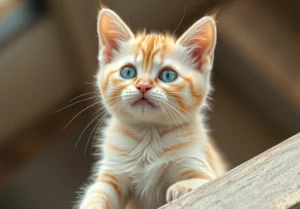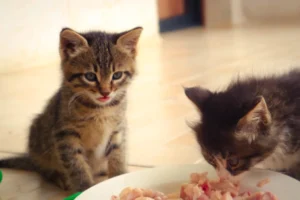Cats are known for their incredible agility and grace, especially when it comes to jumping from high places. Have you ever wondered why cats can jump from so high? Well, the answer lies in their unique anatomy and natural instincts.
Remarkable Muscular Power
Cats are masters of agility, thanks to their remarkable muscular power. Their muscles are like high-performance engines, designed to propel them to incredible heights effortlessly. When a cat jumps, it’s not just a casual leap – it’s a display of raw power in action. Their hind legs are packed with explosive energy, enabling them to spring up to six times their body length in a single bound. This incredible strength allows them to make those seemingly gravity-defying leaps without breaking a sweat.
Flexible Spine and Limbs
Another key element that contributes to a cat’s ability to jump from great heights is their flexible spine and limbs. Picture this: when a cat crouches down before leaping, their spine acts like a coiled spring, storing up potential energy. As they propel themselves upwards, their spine stretches out, releasing all that stored energy in one powerful burst. This flexibility allows cats to adjust their body mid-air, ensuring they land exactly where they intend with impeccable precision. Not to mention, their long, limber limbs provide them with the perfect aerodynamic form to navigate the skies effortlessly.
Additional Unique Insight: Cat’s Tail as a Balancing Tool
A cat’s tail is not just a fluffy adornment – it serves a crucial role in their impeccable jumping skills. While in mid-air, a cat’s tail acts as a counterbalance, helping them land gracefully and maintain their equilibrium. By subtly adjusting the position of their tail, cats can make split-second corrections to ensure they stick their landings flawlessly. So, next time you marvel at a cat’s majestic leap, remember that their tail is playing a silent, yet essential, role in their aerial acrobatics.
Incredible Balance and Coordination
Cats possess incredible balance and coordination that allow them to jump from significant heights without getting hurt. Their inner ear, eyes, and muscular system work together like a well-oiled machine to ensure a smooth landing. The vestibular apparatus in their inner ear helps them maintain their orientation in mid-air, while their eyesight enables them to focus on a landing spot accurately. Furthermore, cats have a flexible backbone that allows for mid-air adjustments, and their powerful leg muscles provide the necessary propulsion to land safely. All these factors combined make cats the ultimate jumpers in the animal kingdom.
Instinctual Behavior
When cats leap from high perches, they rely heavily on instinctual behaviors honed through evolution. These instincts help them gauge distance, adjust their trajectory mid-jump, and make split-second decisions. Cats have an innate ability to estimate distances accurately, ensuring they leap to a safe landing spot. Their keen sense of spatial awareness, coupled with a strong prey drive, motivates them to make daring jumps without hesitation. This instinctual behavior, combined with their physical abilities, makes cats adept at navigating vertical landscapes with ease.
Tips for Cat Owners:
- Ensure your indoor environment has plenty of vertical spaces for your cat to explore and exercise their jumping prowess.
- Provide sturdy scratching posts and cat trees to satisfy your cat’s natural climbing instincts.
- Regularly engage your cat in interactive play sessions to keep their agility and coordination sharp.
Remember, it’s essential to understand and appreciate your cat’s natural instincts and abilities to create a stimulating and enriching environment for them.
Adaptations for Survival
Cats have some serious jumping skills, and it’s not just for show. These agile creatures have evolved over time to be top-notch jumpers for survival. Back in the day, these guys needed to be able to pounce on prey, escape pesky predators, and navigate their environment like pros.
Their strong leg muscles are like built-in springs, allowing them to launch themselves to impressive heights in the blink of an eye. Plus, their flexible spine and powerful hind legs give them the ultimate advantage when it comes to leaping.
So next time you see your furball effortlessly jump onto the countertop, remember they’re tapping into their inner wildcat instincts for survival!
Fun Facts About Cat Jumping
Ready to be amazed by some mind-blowing cat jumping facts? Get this – the average cat can jump up to six times its body length in a single bound! That’s like you jumping the length of a basketball court in one go. Talk about impressive!
Not only that, but cats have a wicked sense of balance, allowing them to stick landings with ninja-like precision. They’re like furry little gymnasts, acing every jump with finesse.
And here’s the kicker – cats can twist their bodies in mid-air to adjust their landing mid-jump. So if your kitty ever misses a leap, don’t worry; they’ve got some serious aerial skills to save the day!
Now, go ahead and impress your friends with these awesome cat jumping facts!
Training Tips for Cat Owners
If you want to boost your feline friend’s jumping prowess, start by incorporating interactive play sessions. Engage them with toys that mimic prey, encouraging them to jump and pounce. Place perches at different heights around your home to entice your cat to leap and climb. Consider investing in a cat tree or shelving units to provide vertical space for them to explore. Reward your cat with treats or praise when they successfully complete a jump, reinforcing positive behavior. Remember, patience and consistency are key in training your cat to jump with confidence.
Training Tips Checklist: 1. Interactive Play Sessions: Engage your cat with prey-like toys. 2. Perches and Climbing Structures: Create vertical spaces for jumping. 3. Positive Reinforcement: Reward successful jumps with treats or praise. 4. Patience and Consistency: Be patient and consistent in your training efforts.
Safety Precautions for High-Jumping Cats
While cats are natural jumpers, it’s essential to create a safe environment to prevent injuries. Avoid placing breakable items or hazardous objects in high places where your cat likes to jump. Install window screens or secure windows to prevent accidents if your cat enjoys perching by the window. Consider providing soft landing spots, such as blankets or cushions, to cushion their jumps. Regularly check for any signs of joint pain or mobility issues, as excessive jumping can strain their muscles and joints. By taking these safety precautions, you can ensure that your high-jumping cat stays happy and healthy.
Safety Precautions Checklist: 1. Secure Hazardous Areas: Remove breakable items from high places. 2. Window Safety: Install screens or secure windows to prevent falls. 3. Soft Landing Spots: Provide cushions or blankets for safe landings. 4. Monitor Joint Health: Watch for signs of joint pain or mobility issues.
The Science Behind Cat Jumping
Did you know that cats have incredible muscle strength in their hind legs? This strength allows them to generate powerful bursts of energy when they jump. In addition, cats have a unique bone structure that enhances their jumping abilities. Their flexible spine and elastic leg muscles act like springs, propelling them to impressive heights. Moreover, cats also possess a heightened sense of balance and coordination, enabling them to execute precise jumps with ease.
Mythbusting Common Misconceptions
Let’s debunk some misconceptions about cats and their jumping prowess. Contrary to popular belief, cats do not always land on their feet when they jump from heights. While they have a remarkable righting reflex that helps them orient their bodies mid-air, they are not invincible to injuries from falls. Additionally, it is a myth that cats can survive any fall, regardless of height. While they have a better chance of surviving falls from higher floors due to their body mechanics and survival instincts, there is still a risk of injury or fatality, especially from great heights.
Additional Unique Insight:
Cats have a specialized collarbone that allows them to rotate their bodies mid-air during jumps, contributing to their acrobatic prowess. This unique anatomical feature helps them land on their feet and adjust their position while in flight. So, the next time you see a cat effortlessly leaping from a height, remember that their collarbone plays a crucial role in their aerial maneuvers.
Environmental Enrichment for Indoor Cats
Did you know that indoor cats benefit greatly from environmental enrichment? Providing your feline friend with opportunities to climb, jump, and explore can help satisfy their natural instincts and keep them physically and mentally stimulated. Cats’ exceptional jumping abilities stem from their evolutionary history as agile hunters, allowing them to pounce on prey from high vantage points. To cater to this instinct, consider investing in tall cat trees, shelves, or window perches that encourage vertical movement. Interactive toys and puzzle feeders can also engage your cat’s hunting instincts and provide mental stimulation. Remember, a happy and enriched cat is a healthy cat!
Ways to Enrich Your Cat’s Environment:
- Install tall cat trees for climbing and jumping.
- Provide shelves and window perches for vertical movement.
- Use interactive toys and puzzle feeders to engage hunting instincts.
- Rotate toys and change up the environment to prevent boredom.
- Create safe outdoor enclosures or harness-train your cat for supervised outdoor adventures.
By incorporating these environmental enrichment strategies, you can enhance your indoor cat’s quality of life and ensure they stay active and content.
The Bond Between Cats and Humans
The strong bond between cats and their human caregivers can be further strengthened through activities that leverage cats’ jumping abilities. Cats often display their affection and trust by choosing to jump onto their human’s lap or shoulder, seeking comfort and closeness. This physical closeness can deepen the emotional connection between feline companions and their owners. Engaging in play sessions that involve jumping and chasing toys together can also foster a sense of teamwork and companionship. By appreciating and encouraging your cat’s jumping prowess, you can cultivate a deeper bond based on shared activities and mutual understanding.
In conclusion, understanding why cats can jump from such heights illuminates the fascinating blend of natural instinct, physical prowess, and emotional connection that underpins the unique relationship between cats and their human counterparts. Let’s continue nurturing these extraordinary abilities and bonds for a harmonious and fulfilling shared journey with our feline friends.
Alex, a passionate animal lover, has experience in training and understanding animal behavior. As a proud pet parent to two dogs and three cats, he founded AnimalReport.net to share insights from animal experts and expand his knowledge of the animal kingdom.




